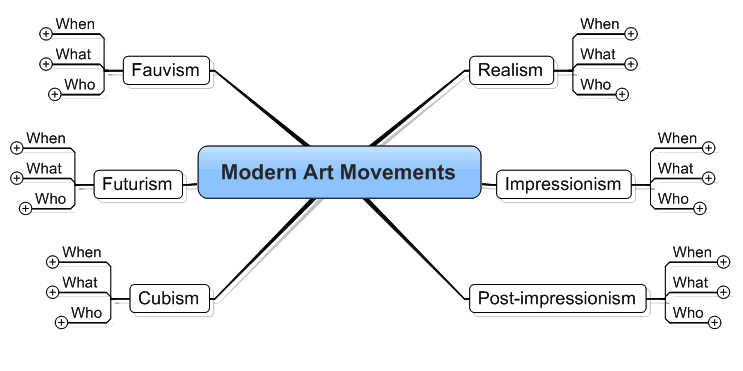It could be put up on a Smart board and used as a prompt for students to review their knowledge of Modern Art movements. I hope to utilise this during my teacher training.
Friday, 24 October 2014
Tuesday, 21 October 2014
Can on-line mind maps enhance Learning & Teaching?
Peter Davies, 'Super Star F***er', 2001
The examples show how creative and expressive a hand drawn mind map can be. They are exciting and engage you in looking and wanting to learn more.
The first on-line mind map I tried making using Bubbl.us, looked dead as a flat balloon in comparison. Mindmup and Stormboard were similarly uninspiring and also a hassle to sign into. So let's focus on a few that I engaged well with.
Creately
I worked intuitively with Creately; it was fun, quick to get going and best of all - very creative. (For dates and names of movements I used about.com which I would recommend to students.) As a first attempt I think it is promising and will develop this to use in class.
text2mindmap was easy to use and quick to start. The mind map is created by typing a list at the side panel of the screen. To have 'trees' organised you simply press tab. It's perfect for building a quick clear mind map with simple objectives.
popplet is great too. I love the way you can easily embed video from YouTube or Vimeo. It's simple and swift to build and could work well in a classroom. A great alternative to PowerPoint; you just click on Presentation mode.
popplet
References
1. http://www.tate.org.uk/art/artworks/salcedo-shibboleth-i-p20334
2. http://www.oxfordlearnersdictionaries.com/definition/english/shibboleth
3. https://www.youtube.com/watch?v=NIJDn2MAn9I
Friday, 10 October 2014
Introduction
I am new to the world of blogging and also to using technology in teaching. So beginning on this Voyage of Discovery of how ICT can be used in the classroom is daunting. I am open minded and believe that ICT is essential in the classroom. The problem is the vast universe of ICT software out there and where to start.
I begin teaching on the First Award in Art and Design on Friday 7th November. My hours of observation have been completed, I have begun to get to know the students and I have written a lesson plan. I feel ready. "ICT in education is the key to unlocking the skills and knowledge of our future generations of young people. It is the tool for learning for the 21st century." (McKenzie, 2014). In this blog I discover if Kate McKenzie's words ring true.
Reference
McKenzie, Kate, (2014) 'ICT in Education is important!'. Available at: http://www.naace.co.uk/1068 [Accessed: 10th October 2014]
I begin teaching on the First Award in Art and Design on Friday 7th November. My hours of observation have been completed, I have begun to get to know the students and I have written a lesson plan. I feel ready. "ICT in education is the key to unlocking the skills and knowledge of our future generations of young people. It is the tool for learning for the 21st century." (McKenzie, 2014). In this blog I discover if Kate McKenzie's words ring true.
Reference
McKenzie, Kate, (2014) 'ICT in Education is important!'. Available at: http://www.naace.co.uk/1068 [Accessed: 10th October 2014]
Subscribe to:
Comments (Atom)




